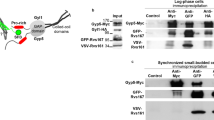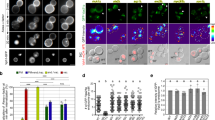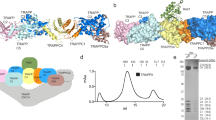Abstract
Ypt–Rab GTPases are key regulators of the various steps of intracellular trafficking. Guanine nucleotide-exchange factors (GEFs) regulate the conversion of Ypt–Rabs to the GTP-bound state, in which they interact with effectors that mediate all the known aspects of vesicular transport1,2,3. An interesting possibility is that Ypt–Rabs coordinate separate steps of the transport pathways4. The conserved modular complex TRAPP is a GEF for the Golgi gatekeepers Ypt1 and Ypt31/32 (Refs 5–7). However, it is not known how Golgi entry and exit are coordinated. TRAPP comes in two configurations: the seven-subunit TRAPPI is required for endoplasmic reticulum-to-Golgi transport, whereas the ten-subunit TRAPPII functions in late Golgi8,9,10. The two essential TRAPPII-specific subunits Trs120 and Trs130 have been identified as Ypt31/32 genetic interactors11,12,13. Here, we show that they are required for switching the GEF specificity of TRAPP from Ypt1 to Ypt31. Moreover, a trs130ts mutation confers opposite effects on the intracellular localization of these GTPases. We suggest that the Trs120–Trs130 subcomplex joins TRAPP in the late Golgi to switch its GEF activity from Ypt1 to Ypt31/32. Such a 'switchable' GEF could ensure sequential activation of these Ypts, thereby coordinating Golgi entry and exit.
This is a preview of subscription content, access via your institution
Access options
Subscribe to this journal
Receive 12 print issues and online access
$209.00 per year
only $17.42 per issue
Buy this article
- Purchase on Springer Link
- Instant access to full article PDF
Prices may be subject to local taxes which are calculated during checkout





Similar content being viewed by others
References
Segev, N. Ypt and Rab GTPases: insight into functions through novel interactions. Curr Opin Cell Biol. 13, 500–511 (2001).
Zerial, M. & McBride, H. Rab proteins as membrane organizers. Nature Rev. Mol. Cell Biol. 2, 107–117 (2001).
Pfeffer, S. R. Rab GTPases: specifying and deciphering organelle identity and function. Trends Cell Biol. 11, 487–491 (2001).
Segev, N. Ypt/rab GTPases: regulators of protein trafficking. Sci. STKE 2001, RE11 (2001).
Jones, S., Newman, C., Liu, F. & Segev, N. The TRAPP complex is a nucleotide exchanger for Ypt1 and Ypt31/32. Mol. Biol. Cell 11, 4403–4411 (2000).
Jedd, G., Richardson, C., Litt, R. & Segev, N. The Ypt1 GTPase is essential for the first two steps of the yeast secretory pathway. J. Cell Biol. 131, 583–590 (1995).
Jedd, G., Mulholland, J. & Segev, N. Two new Ypt GTPases are required for exit from the yeast trans-Golgi compartment. J. Cell Biol. 137, 563–580 (1997).
Sacher, M. et al. TRAPP, a highly conserved novel complex on the cis-Golgi that mediates vesicle docking and fusion. EMBO J. 17, 2494–2503 (1998).
Sacher, M., Barrowman, J., Schieltz, D., Yates, J. R., 3rd & Ferro-Novick, S. Identification and characterization of five new subunits of TRAPP. Eur. J. Cell Biol. 79, 71–80 (2000).
Sacher, M. et al. TRAPP I implicated in the specificity of tethering in ER-to-Golgi transport. Mol. Cell 7, 433–442 (2001).
Yamamoto, K. & Jigami, Y. Mutation of TRS130, which encodes a component of the TRAPP II complex, activates transcription of OCH1 in Saccharomyces cerevisiae. Curr. Genet. 42, 85–93 (2002).
Zhang, C. J. et al. Genetic interactions link ARF1, YPT31/32 and TRS130. Yeast 19, 1075–1086 (2002).
Sciorra, V. A. et al. Synthetic genetic array analysis of the PtdIns 4-kinase Pik1p identifies components in a Golgi-specific Ypt31/rab-GTPase signaling pathway. Mol. Biol. Cell 16, 776–793 (2005).
Gavin, A. C. et al. Functional organization of the yeast proteome by systematic analysis of protein complexes. Nature 415, 141–147 (2002).
Huh, W. K. et al. Global analysis of protein localization in budding yeast. Nature 425, 686–691 (2003).
Segev, N., Mulholland, J. & Botstein, D. The yeast GTP-binding YPT1 protein and a mammalian counterpart are associated with the secretion machinery. Cell 52, 915–924 (1988).
Chen, S. H. et al. Ypt31/32 GTPases and their novel F-box effector protein Rcy1 regulate protein recycling. Mol. Biol. Cell 16, 178–192 (2005).
Novick, P., Ferro, S. & Schekman, R. Order of events in the yeast secretory pathway. Cell 25, 461–469 (1981).
Siniossoglou, S., Peak-Chew, S. Y. & Pelham, H. R. Ric1p and Rgp1p form a complex that catalyses nucleotide exchange on Ypt6p. EMBO J. 19, 4885–4894 (2000).
Bensen, E. S., Yeung, B. G. & Payne, G. S. Ric1p and the Ypt6p GTPase function in a common pathway required for localization of trans-Golgi network membrane proteins. Mol. Biol. Cell 12, 13–26 (2001).
Jones, S., Litt, R. J., Richardson, C. J. & Segev, N. Requirement of nucleotide exchange factor for Ypt1 GTPase mediated protein transport. J. Cell Biol. 130, 1051–1061 (1995).
Wang, W. & Ferro-Novick, S. A Ypt32p exchange factor is a putative effector of Ypt1p. Mol. Biol. Cell 13, 3336–3343 (2002).
Losev, E. et al. Golgi maturation visualized in living yeast. Nature 441, 1007–1010 (2006).
Matsuura-Tokita, K., Takeuchi, M., Ichihara, A., Mikuriya, K. & Nakano, A. Live imaging of yeast Golgi cisternal maturation. Nature 441, 1002–1006 (2006).
Hu, W. H. et al. NIBP, a novel NIK and IKK(beta)-binding protein that enhances NF-(kappa)B activation. J. Biol. Chem. 280, 29233–29241 (2005).
Yamakawa, K. et al. Isolation and characterization of a candidate gene for progressive myoclonus epilepsy on 21q22.3. Hum. Mol. Genet. 4, 709–716 (1995).
Nagamine, K. et al. Genomic organization and complete nucleotide sequence of the TMEM1 gene on human chromosome 21q22.3. Biochem. Biophys. Res. Commun. 235, 185–190 (1997).
Lafreniere, R. G. et al. Genomic structure of the human GT334 (EHOC-1) gene mapping to 21q22.3. Gene 198, 313–321 (1997).
Jones, S., Richardson, C. J., Litt, R. J. & Segev, N. Identification of regulators for Ypt1 GTPase nucleotide cycling. Mol. Biol. Cell 9, 2819–2837 (1998).
Jones, S. et al. Genetic interactions in yeast between Ypt GTPases and Arf guanine nucleotide exchangers. Genetics 152, 1543–1556 (1999).
Rose, M., Winston, F. & Heiter, P. in Methods in Yeast Genetics 146–153 (Cold Spring Harbor Laboratory, Cold Spring Harbor, 1988).
Gietz, D., St. Jean, A., Woods, R. & Schiestl, R. Improved method for high efficiency transformation of intact yeast cells. Nucl. Acids Res. 20, 1625 (1992).
Acknowledgements
We thank D. Stone for critical reading of the manuscript, A. Lodhi for tehcnical help and Y. Jigami for the 2μ Trs130 plasmid. This research was supported by grant GM-45444 from the National Institutes of Health (NIH) to N. Segev.
Author information
Authors and Affiliations
Contributions
N.M., Y.L. and A.A.T. were responsible for the experimental work. S.H.C., J.A., Z.L., V.A.S. and S.D.E. contributed plasmids and strains. R.C. performed sequence analysis. N.S., with the help of the other authors, was involved in project planning, data analysis and writing.
Corresponding author
Ethics declarations
Competing interests
The authors declare no competing financial interests.
Supplementary information
Supplementary Information
Supplementary Figures S1, S2, S3, S4, S5, S6 and Supplementary Table S1 (PDF 2769 kb)
Rights and permissions
About this article
Cite this article
Morozova, N., Liang, Y., Tokarev, A. et al. TRAPPII subunits are required for the specificity switch of a Ypt–Rab GEF. Nat Cell Biol 8, 1263–1269 (2006). https://doi.org/10.1038/ncb1489
Received:
Accepted:
Published:
Issue Date:
DOI: https://doi.org/10.1038/ncb1489
This article is cited by
-
The substrate specificity of the human TRAPPII complex’s Rab-guanine nucleotide exchange factor activity
Communications Biology (2020)
-
An essential role for Arabidopsis Trs33 in cell growth and organization in plant apical meristems
Plant Cell Reports (2020)
-
Rab5-mediated endosome formation is regulated at the trans-Golgi network
Communications Biology (2019)
-
A trapper keeper for TRAPP, its structures and functions
Cellular and Molecular Life Sciences (2012)
-
Molecular architecture of the TRAPPII complex and implications for vesicle tethering
Nature Structural & Molecular Biology (2010)



